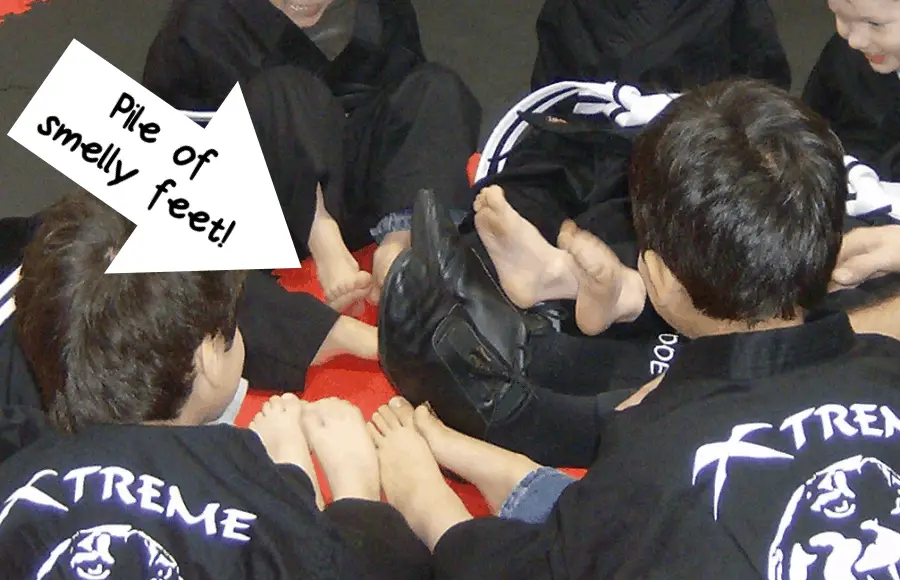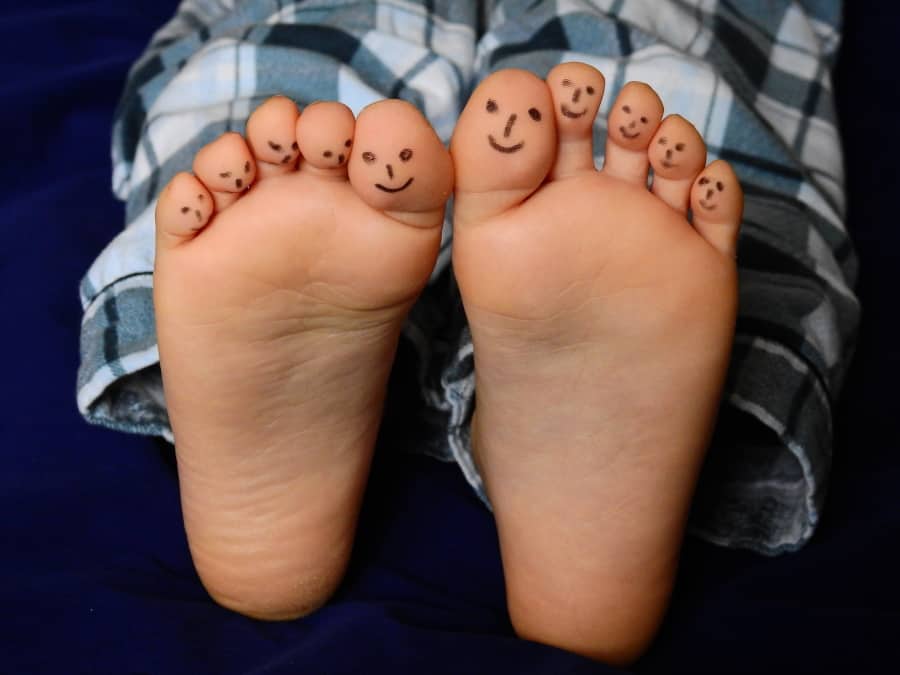
It is a common scene. You walk in to a martial arts class to a room full of little kids, bow tie belts, and bare feet walking on the ends of their pant legs. There are several reasons that these students don’t wear shoes in class. All of them can fit in two main categories.
The ‘No Shoe’ rule exists in martial arts for sanitary reasons and injury prevention. Shoes are worn into the bathroom and therefore not in a training area. Shoes also have laces that can cause cuts with contact. Over protective shoes incite improper kicking technique, which could lead to injuries when other shoes or no shoes are worn.
Now, it has to be said that there really is not a ‘No Shoe’ rule in many current martial arts classes. In today’s market there are many options that are now acceptable in training areas and on mats. I wear martial arts rated shoes all the time when training. Here are my wrestling shoes on Amazon that I use and would recommend. Here are my Karate/TaeKwonDo shoes on Amazon that work best for me.
Contents
No Bare Feet in the Bathroom!
Okay, so the exclamation point was a little much, but this is a thing that happens all too regularly. The studies done about the amount of facile and urine vapor that comes from using and flushing the toilet in your own home, let alone a public one is jaw dropping. That is added to bad aim and accidents to create a rather potent concoction on even the most well maintained restroom floors.
If this is your kind of rabbit hole, here is one research study done about the problem of vapor in the air after flushing the toilet. You could also do a search on ‘toilet plume’, but I wouldn’t. It’s just gross.
The reason I even bring it up is the problem of kids going to the restroom without shoes on and returning with damp feet to the training area. Then a lucky instructor grabs that dampness, trying to show a proper foot angle and… yeah. It is just as unsanitary for other kids, the Karate equipment, and the Little Ninjas coming back from the bathrooms themselves.
There is an easy fix. Shoes on in the bathroom. Shoes off in the training area. This way when a little head of hair rubs on the floor when wrestling or (and it happens) a distracted 3 year old licks the floor, there won’t be as much concern. The licking is still a concern, but what are you gonna do?
Wearing Shoes of Any Type Can Lead to Bad Kicking Form and Future Injuries.
It first must be said that there is a big difference between shoes designed for the martial arts and for other activities. They are softer, thinner, and have specific lightly grabbing traction patters on the souls. This does not mean though that they do not promote slightly different foot technique when maneuvering or kicking.
Not wearing shoes reduces the students reliance on external forms of protection for the foot and aid in traction. The foot placement on targets must be more exact to reduce bruising and prevent minor injuries. This can be of great benefit later when using techniques in other environments and with different types of shoes. It isn’t the shoe that is taking care of the foot, but the students proper technique.
This can come into focus when one considers board breaking, self defense, and then there is the corner of that blamed coffee table that I never wanted in the first place… but I digress.
What About Those Karate, TaeKwonDo, or Wrestling Shoes?
Sure, as I listed before, I have my shoes that I wear and personally I have no problem with them in grappling, weapons, or striking arts. Although, there are a few considerations. If there weren’t I think everyone would be wearing martial arts shoes in all classes. To be honest, I don’t plan on defending myself or my family barefooted, and definitely won’t remove my shoes before an incident. Yet, there are actual things to consider.

Instructor Preference Is Important
Instructors can have a strong opinion either way on the issue. Some of the concerns could be due to mat or flooring durability, injury risks, and it not actually addressing the problem of either sanitary or injury concerns.
An Instructor’s Sanitary Concerns
Wait, sanitary concerns? Doesn’t wearing martial arts shoes fix that problem? Maybe for those wearing them, but not totally. It is a sad fact, but the human brain usually only does something if it gets payment for it. This payment can be the satisfaction of being a good person or the feeling of being above the rules. It varies on so many factors.
Following the rules instead of personal convenience is not a sure thing. It may even be subconscious at times, but just think about how many people actually go the speed limit and you will get the picture.
This leads to many occurrences of martial arts shoes entering the bathroom and the same problem happening as with those not wearing them. The child wearing the shoes may be protected, but others won’t be. For many instructors, the safest solution is only to allow the shoes that you wear ‘on the street’ enter the restrooms. Martial arts shoes are never to enter those petri dishes.
Wear and Tear on Flooring and Mats
Martial arts shoes have a small amount of tread on rubber souls. If the training area doesn’t have mats, there is usually no issue at all. There may be those highly polished wooden floors in a very traditional martial arts setting, but more on that in the next section. Those floors that are covered with mats pose a real problem over the long haul.
Mats are expensive. They are arguably the most expensive part of a martial arts school location. They aren’t necessary for most styles except for those taking direct falls. That being said, many people expect them to be on the floors of martial arts schools as the norm. This is an expensive proposition for a school owner. Very expensive.
With prices for mid-tier brand mats running $398 to $798 for a 10’x10′ area, you can see why they would want those mats to stay clean and unworn as long as possible. The problem with wear and tear may apply in the long term, there is also the scuffs and marks that these shoes can put on them if they are not of the highest quality.
For theses reasons, many instructors with mats in their training spaces won’t want any type of shoes worn. It is the price you pay for having the latest fad in flooring in your child’s martial arts space.
Just for reference, in LA I trained outside over half of the time due to good weather. We would do complete throws and take downs on grass surfaces with no problem. Mats are simply the look and feel many want in a dojo today. Though, out of concern for others, I had indoor mat only shoes and outside training shoes (my gear bag was full).
Tradition
Every time I hear that word Tevye from Fiddler on the Roof begins singing in my head with his arms waving in the air. Tradition actually works the same way in the martial arts as it does in that musical. Tradition holds some back, but keeps some grounded with a solid footing. It is there none the less and if you want a true experience from an Asian culture in your training, shoes are a no-go.
In my house, because of my life in the martial arts, no one wears shoes. It is a cleanliness thing that hit my wife and I when our kids were crawling around on our carpets just after someone came in from outside or the bathroom. From then on we followed the Japanese tradition that no shoes made it more than a few feet from the front door.
In very traditional Japanese Karate and Judo dojos students are required to have slippers. This is common in many Japanese homes. Slippers are worn inside houses and all shoes are left in a rack or closet near the door. In traditional dojos, no shoes are allowed past the door, slippers are worn in the common areas, and no shoes or slippers are permitted on the mats or training floor.
You can see how that tradition can, if everyone follows it create a much more sanitary environment. Let me tell you, I have grappled on some nasty mats. The only thing that saved me from skin rashes were my rash guards.
We have surfers to thank for the prevalence of rash guard shirts in the martial arts today. I wear one every day. Here are the ones on Amazon that I use. Long sleeve rash guards can be very expensive, and for no good reason I might add. These that I use are great and inexpensive.
What Does Research Say About Kids and Barefeet?
- According to a study published in Pediatrics the Official Journal of the American Academy of Pediatrics, for kids the “optimum foot development occurs in the barefoot environment”. It goes on to conclude that shoe selection should be based on protection of the feet from injury and infection and as close as possible the barefoot condition.
- On the other hand, many can go too far with this sort of research without viewing conclusions from other studies that say habitually not wearing shoes can slow arch development. This study warns against taking such drastic stances about whether children should always be shod or not. Moderation is advised.
There are just as conclusive studies on both sides of the argument. What one can take from it is that the right shoes for some occasions and no shoes for others is a great way to give intelligent parents options to apply to their individual Little Ninjas.
The Barefoot Takeaway…
Is there a preference you have for footwear in a martial arts class? Talk to your instructor. Many times they will advise options for shoes if you would like them and the etiquette on how they should be used. Barefoot is great, as long as shoes not used in training are utilized for bathroom trips.
As for injuries due to training wearing shoes, it is not actually as big of a concern as some may make it out to be. If for some reason a student needs to use barefooted self defense, it is not likely that any injury incurred will be because of not being used to barefooted practice. When board breaking time comes, it may be a bit more nerve wracking, but that will be about it. Wearing martial arts shoes in training is fine, and so is going with bare feet.
